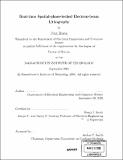Real-time spatial-phase-locked electron-beam lithography
Author(s)
Zhang, Feng, 1973-
DownloadFull printable version (15.99Mb)
Alternative title
Real-time SPLEBL
Other Contributors
Massachusetts Institute of Technology. Dept. of Electrical Engineering and Computer Science.
Advisor
Henry I. Smith.
Terms of use
Metadata
Show full item recordAbstract
The ability of electron-beam lithography (EBL) to create sub-10-nm features with arbitrary geometry makes it a critical tool in many important applications in nanoscale science and technology. The conventional EBL system is limited by its poor absolute-placement accuracy, often worse than its resolution. Spatial-phase-locked electron-Beam lithography (SPLEBL) improves the placement accuracy of EBL tools to the nanometer level by directly referencing the beam position via a global-fiducial grid placed on the substrate, and providing feedback corrections to the beam position. SPLEBL has several different modes of operation, and it can be applied to both scanning electron-beam lithography (SEBL) and variable-shaped-beam lithography. This research focuses primarily on implementing real-time SPLEBL in SEBL systems. Real-time SPLEBL consists of three major components: a fiducial-reference grid, a beam-position detection algorithm and a partial-beam blanker. Several types of fiducial grids and their fabrication processes were developed and evaluated for their signal-to-noise ratio and ease of usage. An algorithm for detecting the beam position based on Fourier techniques was implemented, and -1 nm placement accuracy achieved. Finally, various approaches to partial-beam blanking were examined, and one based on an electrostatic quadrupole lens was shown to provide the best performance.
Description
Thesis (Sc. D.)--Massachusetts Institute of Technology, Dept. of Electrical Engineering and Computer Science, 2005. Includes bibliographical references (p. 131-139).
Date issued
2005Department
Massachusetts Institute of Technology. Department of Electrical Engineering and Computer SciencePublisher
Massachusetts Institute of Technology
Keywords
Electrical Engineering and Computer Science.